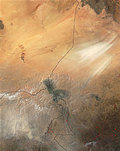 據一份新研究指出,整個巴西雨林肥沃的土壤,事實上是源自於非洲查德的一處山谷,谷內塵土橫渡大西洋數千英哩,最後抵達南美成為雨林植物最不可或缺的土壤。
據一份新研究指出,整個巴西雨林肥沃的土壤,事實上是源自於非洲查德的一處山谷,谷內塵土橫渡大西洋數千英哩,最後抵達南美成為雨林植物最不可或缺的土壤。
此項研究是根據衛星資料進行,是由克倫博士為首的國際研究團隊所執行,該研究團隊隸屬於座落在瑞荷渥特的魏茨曼科學學院。資料顯示有56%到達巴西亞馬遜河雨林的塵土是來自於查德北方的巴德里村。
克倫博士和其來自於以色列、英國、美國和巴西的同事綜合各項衛星資料,並第一次測量塵土重量。
他們指出每年有總數約5千萬噸的非洲塵土降落在亞馬遜地區,比以往估量的1300萬噸還多。科學家表示,新的測量計算這些土壤能提供維持亞馬遜雨林生存所需的礦物質量。
他們計算這5千萬噸的塵土有56%來自於查德湖東北方的巴德里村。研究人員表示巴德里村是非常重要的塵土來源,原因是它的形狀和地理特徵。它的兩側是許多由玄武岩構成的山脈圍繞,形成一個在東北方有狹窄開口的圓錐狀凹陷。
克倫博士說,就像光線經過鏡片會聚焦一樣,風會由漏斗狀的開口吸入村莊,而形成一個巨大的風洞。結果表面的風會加速並往風洞吹,將土壤帶離地面吹向西方的大西洋。風勢讓巴德里村吹出上百萬噸塵土,最後在亞馬遜雨林落腳。
有關巴德里村的研究將會在新發行的環境研究通訊季刊第一輯(2006年10到12月)中發表。
Much of the dust needed for fertilizing the entire Brazilian rainforest originates in a single valley in the African country of Chad and travels thousands of miles across the Atlantic Ocean to South America, newly published research shows.
Based on satellite data, the study was conducted by an international research team headed by Dr. Ilan Koren of the Environmental Sciences and Energy Research Department at the Weizmann Institute of Science in Rehovot. The data revealed that some 56 percent of the dust reaching the Brazilian Amazon rainforest comes from the Bodélé Valley in northern Chad.
By combining various types of satellite data, Dr. Koren and colleagues from Israel, the United Kingdom, the United States, and Brazil have for the first time measured the weight of this dust.
They showed that a total of some 50 million tons of African dust is deposited upon the Amazon region every year, a much higher figure than the previous estimates of 13 million tons. The new estimate matches calculations on the quantity of dust needed to supply the vital minerals for the continued existence of the Amazon rainforest, the scientists say.
They calculate that 56 percent of the 50 million tons of dust originates in the Bodélé Valley located northeast of Lake Chad. The researchers suggest that the Bodélé Valley is such an important source of dust due to its shape and geographic features. It is flanked on both sides by enormous basalt mountain ridges, which create a cone shaped crater with a narrow opening in the northeast.
Dr. Koren says winds that "drain" into the valley focus on this funnel-like opening the way light is focused by an optical lens, creating a large wind tunnel. As a result, gusts of surface wind that are accelerated and focused in the tunnel lift the dust from the ground and blow it westward toward the Atlantic Ocean. This wind action allows the Bodélé Valley to export the millions of tons of dust that sustain life in the Amazon rainforest.
The Bodélé Valley study was published in the first issue of the new quarterly journal "Environmental Research Letters," dated October - December 2006.






